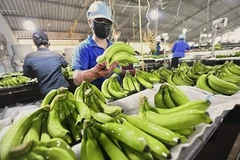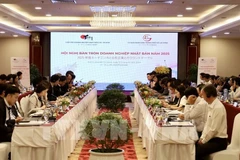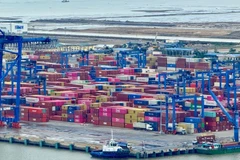 Minister of Planning and Investment Planning and Investment Nguyen Chi Dung speaks at the conference. (Photo: VietnamPlus)
Minister of Planning and Investment Planning and Investment Nguyen Chi Dung speaks at the conference. (Photo: VietnamPlus)
Hanoi (VNA) – To achieve the goal of the green growth strategy, Vietnam needs to take more drastic and breakthrough steps to bring the size of green economy to the milestone of 300 billion USD by 2050, Minister of Planning and Investment Planning and Investment Nguyen Chi Dung said at a conference on green growth on April 18.
Presiding over the conference, Minister Dung emphasised that green growth is an important solution to promote economic restructuring in association with an innovation-based growth model and improve competitiveness and resilience to external shocks. Moreover, green growth will directly contribute to reducing greenhouse gas emissions to realise Vietnam’s commitment to net zero emissions by 2050.
With its potential and geo-economic position in the global supply chain, Vietnam is having a huge opportunity for green growth.
“Vietnam identifies green growth as a long-term option to ensure balance and harmonise the goal of reducing total greenhouse gas emissions with economic development,” Dung said.
 With its potential and geo-economic position in the global supply chain, Vietnam is having a huge opportunity for green growth. (Photo: VietnamPlus)
With its potential and geo-economic position in the global supply chain, Vietnam is having a huge opportunity for green growth. (Photo: VietnamPlus)
Research from Boston Consulting Group (BCG) shows that the wind and solar power industries could contribute up to 70-80 billion USD to the GDP and create about 90,000-105,000 direct jobs. In addition, the clean hydrogen ecosystem based on renewable energy has the potential to contribute 40-45 billion USD to the annual GDP, create about 40,000-50,000 jobs, and benefit the domestic market and export. However, to achieve the green growth goal, Vietnam needs to focus on the most essential industries and fields to help Vietnam activate its natural advantages and rise to become a developed country across all three factors - environmental, economic, and social by 2045.
Jaime Ruiz-Cabrero, General Director of BCG Southeast Asia, said that the world's leading countries are accelerating the development of technology solutions to transform into a green, clean, and low-carbon economy. This opens up opportunities for Vietnam to catch up with the trend and become a leader in clean technology in the region and possibly globally.
Jaime said Vietnam needs to perfect the green strategic institutions and relevant legal framework; strengthen the construction of a stable green financial system that helps reduce investment capital costs; develop the grid infrastructure system, create a foundation for the development of clean and renewable energy sources; and accelerate the development of clean hydrogen ecosystem.
Le Viet Anh, Director of the Department of Science, Education, Natural Resources and Environment under the Ministry of Planning and Investment, said that the department will prioritise the implementation of the green growth strategy by building investment mechanisms and policies, perfecting policies and legal frameworks, and improving access to investment resources.
In particular, the ministry will coordinate with other ministries, agencies, and localities to develop a list of key green growth projects as well as green financial tools that are suitable for Vietnam and the new international context.
Approved in September 2012, the Vietnam Green Growth Strategy is an effort to synthesise green action plans of major sectors and society to promote “green production” via more efficient use of resources and new technologies.
It aims to reduce greenhouse gas emissions by 8-10% as compared to the 2010 level; reduce energy consumption per unit of GDP by 1-1.5% per year; reduce greenhouse gas emissions from energy activities by 10-20% compared to the business as usual case.
This commitment includes a voluntary reduction of approximately 10% and an additional 10% reduction with additional international support. This objective underlines Vietnam’s commitment to low carbon growth and to global efforts to mitigate climate change.
Through the strategy, Vietnam also encourages green lifestyles and promotes sustainable consumption./.






























